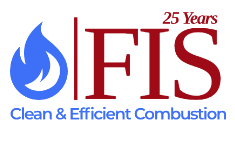Efficiency Improvement of 4H-102 and 5H-205 Heaters
In 2009, FIS conducted an efficiency improvement study for Depentanizer Reboilers (H-102 and H-205). A refinery in East Texas wished to increase absorbed duty of their heaters by 10%.
The heaters were originally designed in 1972 as a vertical cylindrical type, natural draft heaters with horizontal convection section and a top mounted stack. Both the heaters were designed for an absorbed heat duty of 46.2 MMBtu/hr (4H-102) and 33.7 MMBtu/hr (5H-205) respectively.
Capacity Improvement:
FIS was solicited by the refinery to develop an economical scheme for improving the efficiency of their heaters. Operating data analysis of the heaters portrayed that the convection sections were fouled. FIS evaluated three options to redesign the convection section. However, based on available pressure drop and targeted efficiency improvement, FIS patented Split Flow Technology was selected.
The Split Flow Technology aims to improve the utilization of thermal energy for process heating. This design works very well to increase the capacity of fired heaters without increasing the process side pressure drop. This is achieved by splitting the process fluid into two parallel streams as- Main Stream and Split Stream. In Main Stream the fluid is heated in the radiant section. In Split Stream the fluid is heated in convection section. The two streams are then combined at the heater outlet.

